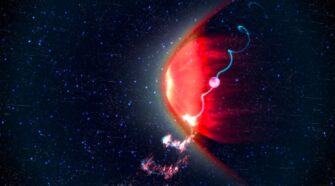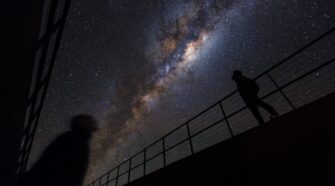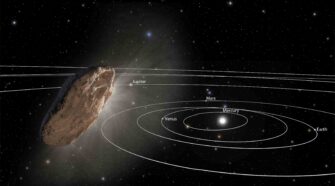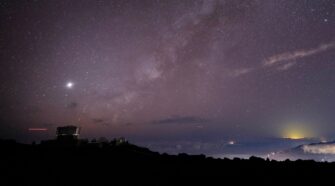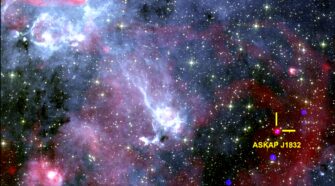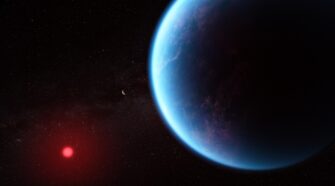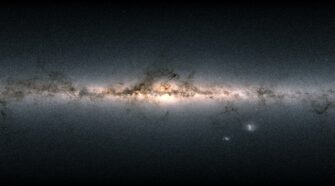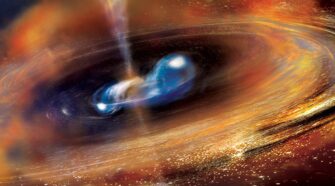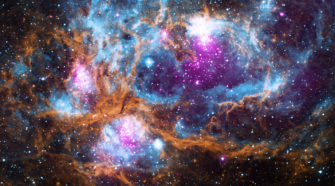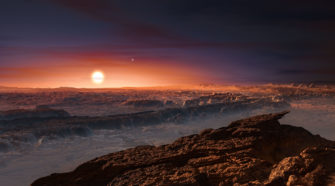Milky Way
Twinkling star reveals the secrets of plasma structures in our cosmic neighbourhood
With the most powerful radio telescope in the southern hemisphere, we have observed a twinkling star and discovered an abundance of mysterious plasma structures in our cosmic neighbourhood. The plasma structures we see are variations in density or turbulence, akin to interstellar cyclones stirred up by energetic events in the galaxy. The study, earlier this …
When you wish upon a star, is it already dead?
Deep in the Chilean Desert, astronomers witness a skyscape like few others on Earth. Credit: ESO/Luis Calçada/Herbert Zodet When you wish upon a star, Jiminy Cricket told us, your dreams come true. But according to an idea doing the rounds on social media, that may not be the case: According to astronomy, when you wish …
Here’s how we can study interstellar objects passing through solar system
In late 2017, a mysterious object tore through our solar system at breakneck speed. Astronomers scrambled to observe the fast moving body using the world’s most powerful telescopes. It was found to be one quarter mile (400m) long and very elongated – perhaps 10 times as long as it was wide. Researchers named it ‘Oumuamua, …
Another puzzling interstellar object spotted whizzing through solar system
Astronomers manning an asteroid warning system caught a glimpse of a large, bright object zipping through the solar system late on July 1, 2025. The object’s potentially interstellar origins excited scientists across the globe, and the next morning, the European Space Agency confirmed that this object, first named A11pl3Z and then designated 3I/ATLAS, is the …
X-rays reveal a mysterious cosmic object never before seen in galaxy
In a new study published recently in Nature, we report the discovery of a new long-period transient – and, for the first time, one that also emits regular bursts of X-rays. Long-period transients are a recently identified class of cosmic objects that emit bright flashes of radio waves every few minutes to several hours. This …
Potential sign of life found on a distant planet and why many are still skeptical
A team of astronomers announced on April 16, 2025, that in the process of studying a planet around another star, they had found evidence for an unexpected atmospheric gas. On Earth, that gas – called dimethyl sulfide – is mostly produced by living organisms. In April 2024, the James Webb Space Telescope stared at the …
Gaia telescope ends mission to create 3D map of Milky Way
On Thursday 27 March, the European Space Agency (ESA) sent its last messages to the Gaia Spacecraft. They told Gaia to shut down its communication systems and central computer and said goodbye to this amazing space telescope. Gaia has been the most successful ESA space mission ever, so why did they turn Gaia off? What …
Unusual, long-lasting gamma-ray burst challenges theories
The big idea A bright flash of gamma rays from the constellation Boötes that lasted nearly one minute came from a kilonova, as we described in a new paper. This finding challenges what astronomers know about some of the most powerful events in the universe. The unusual cosmic explosion was detected by the Neil Gehrels …
NGC 6357: A cosmic ‘winter’ wonderland
Although there are no seasons in space, this cosmic vista invokes thoughts of a frosty winter landscape. It is, in fact, a region called NGC 6357 where radiation from hot, young stars is energizing the cooler gas in the cloud that surrounds them. This composite image contains X-ray data from NASA’s Chandra X-ray Observatory and …
Nearest star has planet in habitable zone
Earth-mass world spotted in orbit around Proxima Centauri Astronomers using ESO telescopes and other facilities have found clear evidence of a planet orbiting the closest star to Earth, Proxima Centauri. The long-sought world, designated Proxima b, orbits its cool red parent star every 11 days and has a temperature suitable for liquid water to exist …

